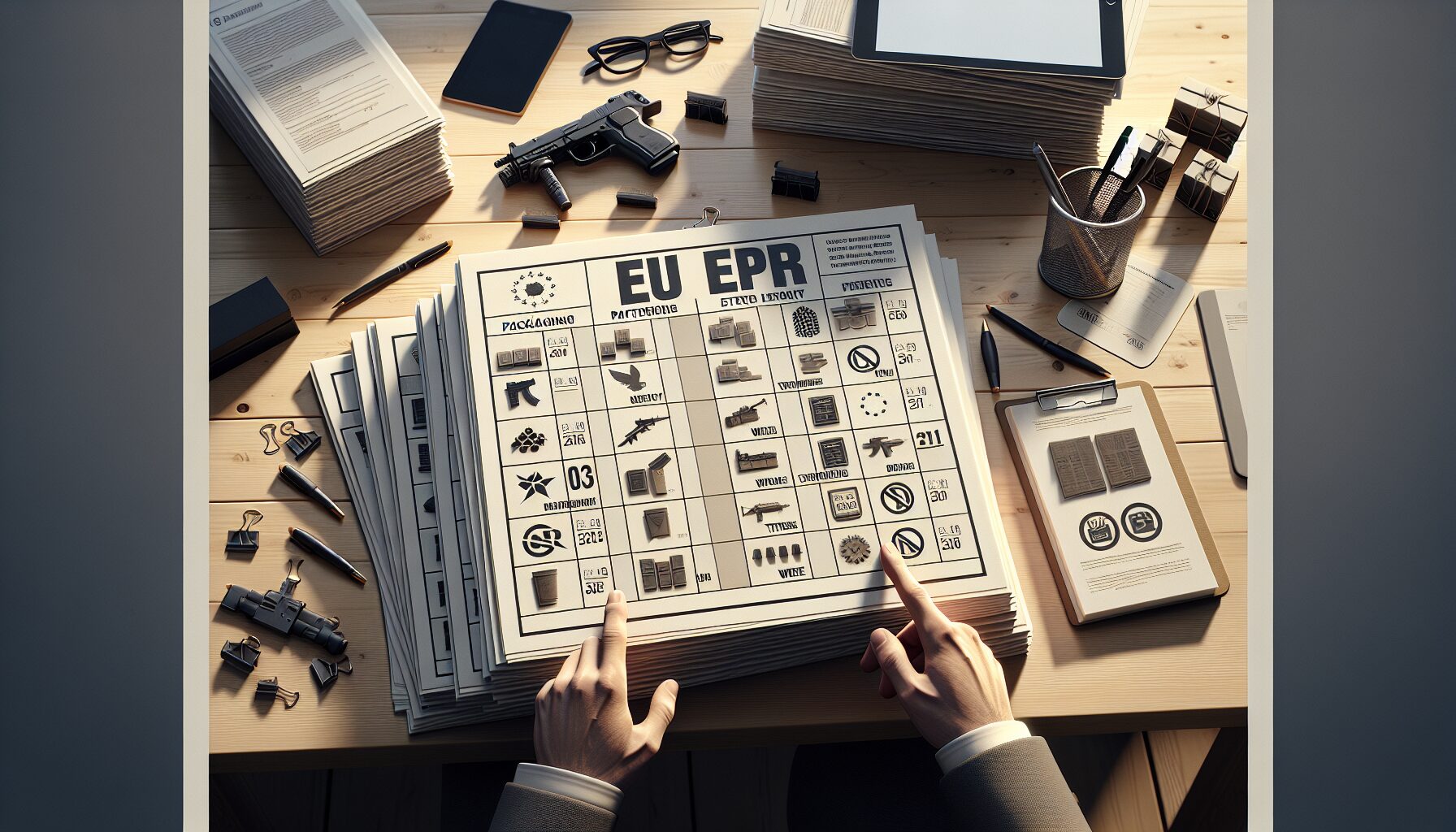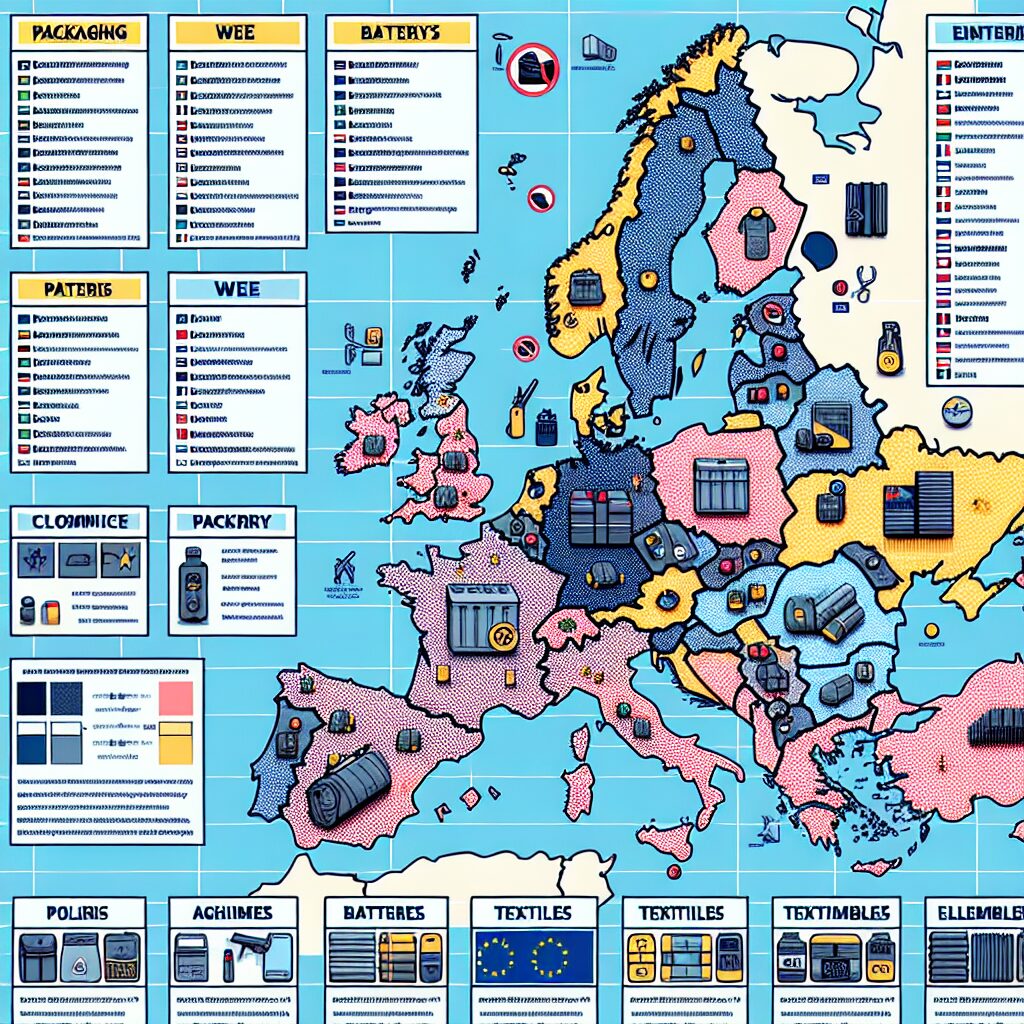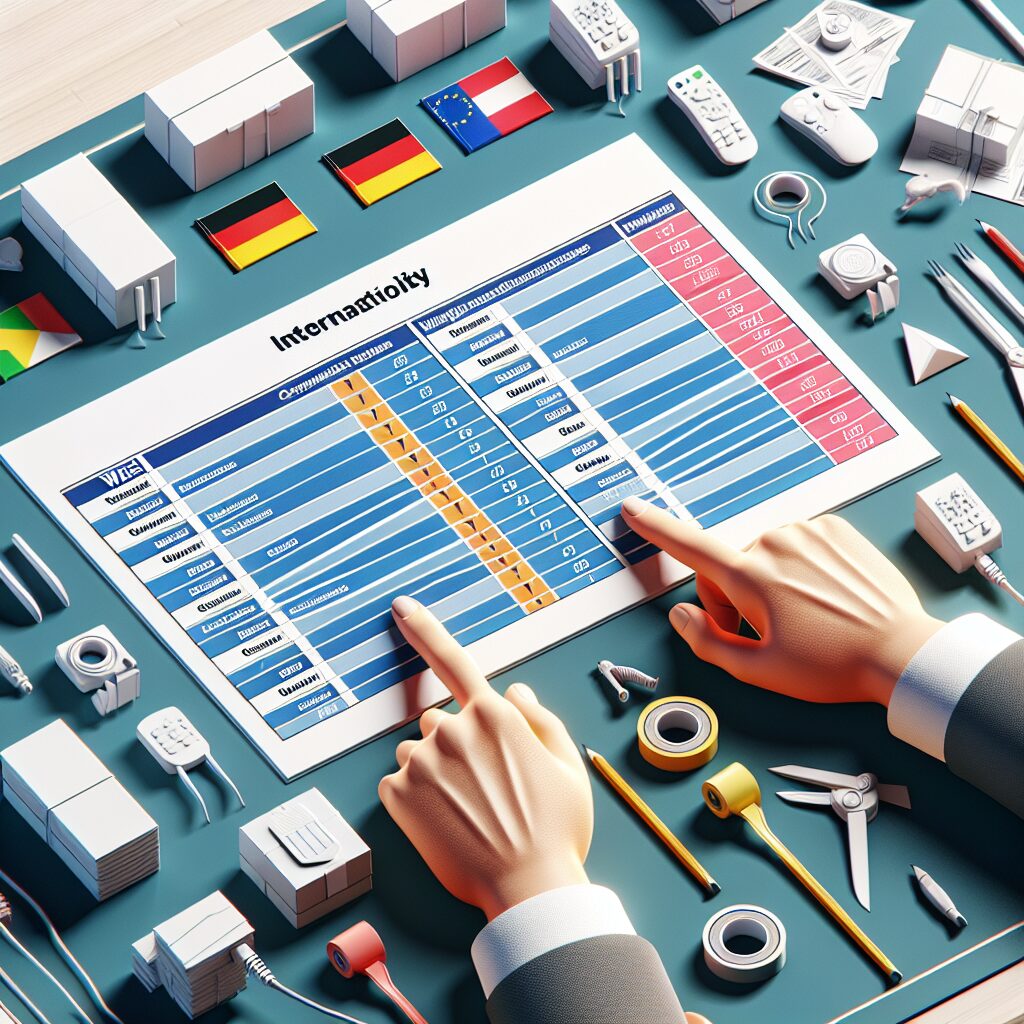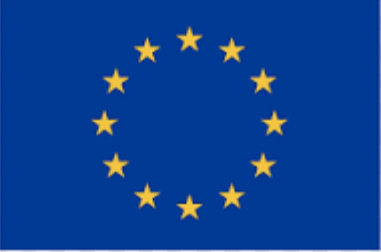About eldris
Epr.eldris.ai leads the EPR sector, in fast, automated, AI Agent EU Complaince. LUCID Packaging, WEEE, and Battery Compliance for Brands, E-Commerce and Service based businesses expanding into the EU.
In This Article
- Track 2025 EPR deadlines across all 27 EU member states using a detailed calendar.
- Ensure compliance in packaging, WEEE, battery, and textile categories based on local regulations.
- Avoid fines and seller account suspension by registering before your country’s specific deadline.
- Assign internal leads or agents to oversee submission of reports and fees.
- Stay informed on upcoming EU packaging law revisions to stay ahead of compliance trends.
Overview of EU EPR Deadlines for 2025
Why 2025 is Critical for EPR Compliance
The year 2025 marks a pivotal moment for Extended Producer Responsibility (EPR) enforcement across the European Union. With harmonisation initiatives underway and new local implementations entering into force, businesses that sell in the EU must track and comply with specific national EPR deadlines 2025. Failure to do so may result in severe penalties, marketplace removal, or reputational damage. The legal foundation set by various EU directives—such as the Packaging Waste Directive, WEEE Directive, and Batteries Directive—has now been fully transposed into local statutes in most countries. For companies operating EU-wide, understanding the different national deadlines and required documentation is no longer optional—it is a business imperative. Whether you sell packaged goods, electronics, batteries, textiles, or more, EPR obligations hinge on accurate and timely registration. The EPR deadlines 2025 signal the shift from flexibility to enforcement, prompting proactive action from sellers across all scales and verticals.

Key Categories for EPR: Packaging, WEEE, Batteries, Textiles
What Sellers Must Register For
As regulatory enforcement intensifies, companies must closely monitor category-specific EPR requirements. The most prominent EPR categories relevant to the 2025 deadlines include: Packaging, Waste Electrical and Electronic Equipment (WEEE), Batteries, and increasingly, Textiles. Sellers of physical goods must determine their responsibility within each of these pillars. For packaging, this means registering the total volume and material composition used to deliver goods into each EU country. WEEE, by contrast, applies to producers of electronics including laptops, smartphones, kitchen appliances, and medical devices. Battery EPR covers portable, industrial, and automotive batteries placed on any EU market. Meanwhile, a wave of regulation around textiles is taking hold. France leads the way under the REP Textiles scheme, and other nations are following. By 2025, more countries will require textile producer registration for clothing, footwear, and household fabrics. For sellers, this means analysing your product catalogue and sales flow by destination country to pinpoint where and what EPR obligations exist across categories. Tools such as the 2025 EPR calendar help facilitate this strategic planning.
Country-by-Country Breakdown of 2025 EPR Deadlines
Notable Differences in National Schemes
Despite being part of a single market, EU countries implement EPR laws differently. That makes understanding each country’s unique EPR deadlines in 2025 critically important. Germany, for example, mandates registration with the Central Packaging Register (LUCID) before any products can be shipped. France requires registration with multiple Producer Responsibility Organisations (PROs), depending on the product type. Spain’s EPR rules underwent dramatic change in 2023, and sellers must now navigate diverse requirements under Royal Decree 1055/2022. Italy presents added complexity with different PROs per product category, including CONAI for packaging and COBAT for WEEE. The Netherlands, well ahead in EPR enforcement, often audits importers for compliance. Denmark and Sweden are introducing new reporting interfaces that will apply mandatory EPR data disclosures by Q3 of 2025. Sellers should consult the EPR calendar covering each country’s laws and deadlines. This tailored insight enables internal teams to establish proactive compliance timelines and avoid gaps in registration. You may find Learn more about EU EPR registration and compliance strategies useful for keeping up with individual state deadlines by quarter.
Marketplaces and EPR: Amazon and Beyond
Why Timely Registration Impacts Seller Accounts
Major online marketplaces—particularly Amazon—are enforcing EPR compliance more strictly than ever in 2025. Sellers that fail to register their products by the required EPR deadlines face real business risk, including product listing removal and suspended payment disbursement. Amazon now requires Extended Producer Responsibility registration numbers (EPRNs) for listings in France and Germany across packaging, WEEE, and batteries. Other EU marketplaces like Otto, Cdiscount, and Bol.com also demand compliance documentation before allowing listings to go live. If your EPR compliance is not confirmed before posting goods, your items may be delisted, and your account flagged as non-compliant. With the 2025 deadlines cemented across marketplace partners, sellers are urged to centralise their registrations and reporting processes now. This includes working with compliance agents and Responsible Persons to ensure their obligations are met—especially where local language, residency, or tax representation rules apply. EU packaging waste regulations overview highlights how MAR (Marketplace Accountability Regulations) intersect with EPR for cross-border traders.
EPR Calendar PDF: How to Use It
A Tool for Internal Compliance Teams
The EPR deadlines 2025 calendar is more than just a static document—it’s a strategic compliance planning tool. Available as a downloadable PDF or integrated calendar feed, this document lists each EU country’s required categories and corresponding reporting or registration dates. Internal regulatory teams can use it to map out annual compliance workflows across departments. By aligning marketing, operations, and tax teams, sellers can ensure that EPR deadlines for packaging, WEEE, batteries, and textiles receive the correct internal focus. If you’re a seller with decentralised logistics, this calendar supports localisation of compliance tasks per distribution point. The PDF includes embedded notes on unique local reporting formats, PRO contact details, and URLs for online submission portals. Organising your EPR readiness by Q1 2025 using this resource allows teams to avoid last-minute liabilities. For an updated version that reflects regulatory changes, visit Read a related article.
How to Register for EPR in Multiple EU States
Centralising Your EPR Obligations
Operating across several EU nations creates complexity in EPR registration, given the non-harmonised state of rules. However, it is possible to streamline the process by centralising oversight and executing registration through dedicated service providers. The first step is consolidating your EU sales data and inventory flow by destination country and product category. This will determine in which jurisdictions you have EPR obligations. Companies can then work with third-party EPR agents or local consultants to handle country-specific filings, often under Power of Attorney. These agents register your brand with local PROs, translate and submit required documentation, and manage correspondence with regulatory bodies. Technology platforms can integrate EPR dashboards with your order management tools, streamlining label generation and category mapping. Registering before the critical EPR deadlines 2025 ensures uninterrupted ability to trade on marketplaces and meet customer expectations. EPR Responsible Person solutions for brands explores the use of multi-country EPR compliance dashboards and service models that empower global brands to act locally.
Penalties for Missing EPR Deadlines
Common Fines and Enforcement Risks
Failure to meet EPR deadlines in 2025 can lead to substantial penalties. These vary by jurisdiction but generally include financial fines, marketplace delisting, customs disruptions, and legal action. Germany, for instance, imposes penalties up to €200,000 or product bans for non-registered producers. France may block logistics channels or initiate legal actions regarding non-licensed brands operating without proper PRO affiliation. Marketplaces may disable offending seller accounts indefinitely. Customs authorities in countries like Belgium and Austria have started working more closely with environmental regulators. A shipment tagged as non-compliant under local EPR rules may be held, returned, or destroyed. Businesses that neglect deadlines could receive negative business ratings or sustainability scores, impacting their ESG credibility. Regulatory scrutiny—especially for sellers lacking local establishments—has intensified. Authorities are cross-verifying VAT and EPR compliance formats. Missing a deadline is not merely a clerical issue; it is a commercial liability. The best protection is proactive registration and regular documentation audits ahead of each reporting cycle.
EU-wide Trends and Upcoming Regulatory Changes
Preparing Beyond 2025
The EPR landscape is expected to undergo even more transformation after 2025. The European Commission is preparing revised legislation to harmonise EPR schemes for textile and construction materials, including mandatory environmental labelling. The Packaging and Packaging Waste Regulation (PPWR), currently under debate in Brussels, could introduce harmonised recyclability standards, deposit return schemes, and e-commerce traceability obligations. These regulatory overhauls are designed to simplify and unify EPR compliance but will likely raise the operational threshold for producers. Countries such as Sweden, Finland, and Portugal are also digitising producer registers to enable live compliance checks from 2026 onwards. This means real-time auditability and fewer grace periods. Businesses must cultivate adaptable compliance infrastructures, and not view EPR as a one-time exercise. Digital EPR tokens, QR-based tracking, and smart packaging labels are on the horizon. Brands that build holistic frameworks in response to the EPR deadlines 2025 will be positioned strongly as the framework evolves.
Getting Support: Responsible Person and Agents
Who Can Represent Your Business
For non-EU established businesses, meeting EPR obligations requires appointing an EU-based Responsible Person or local authorised representative. This individual or entity acts on your behalf to register your brand with national PROs, manage compliance mail, authorise audit responses, and ensure all EPR deadlines are fulfilled. Selecting a qualified Responsible Person is particularly crucial for Amazon and eBay sellers based outside Europe. It is important their credentials meet local legal expectations—residency, professional licensure, and communication capabilities in the native language. Several service providers now act as EPR agents, offering multi-jurisdiction representation along with automated portals to upload SKU-level EPR data. Businesses are advised to vet their agents carefully. Ensure they can operate across the EU-27 and can scale with your expansion goals. Clarifying their responsibilities before 2025 will remove registration obstacles and streamline long-term reporting. Make sure Service Level Agreements cover submission frequencies, PRO interactions, and multi-language documentation support.
Checklist: What You Need to Stay Compliant
Step-by-Step for 2025 Readiness
To keep pace with the EPR deadlines 2025, businesses should follow these pragmatic steps:
- Conduct a product compliance audit: identify affected categories—packaging, WEEE, batteries, textiles.
- Verify destination countries for each sale and match them with their national EPR requirements.
- Designate an internal EPR lead or external agent who will own compliance across borders.
- Engage with Producer Responsibility Organisations early to obtain registration numbers.
- Compile evidence of SKU-level compliance: labels, declarations, weight data.
- Create a Q1 2025 compliance calendar to track submission dates, renewals, and audits.
- Ensure all marketplace listings carry correct EPR identifiers from day one.
- Review and test documentation pipelines—your files must match each PRO’s format.
- Consider publishing your compliance framework in annual ESG or sustainability reports.
- Monitor EU legislative updates monthly for possible legal amendments or new category inclusion.
“Taking proactive ownership of EPR compliance before 2025 avoids fines, protects revenue, and signals that your brand operates responsibly within the EU.”
Final Thoughts on EU EPR Calendar 2025
As the EPR deadlines 2025 become ever more entrenched in the compliance landscape, businesses must prioritise action. These are not soft guidelines—they are binding obligations with material consequences. Sellers of all sizes must embrace tools such as the EPR calendar, enlist capable partners, and embed compliance into their cross-border operational flow. This calendar year stands as the point when EPR oversight shifts from optional to essential, and only brands with professionalised compliance infrastructure will continue to thrive in the EU market. Prepare, act, and document. In doing so, you preserve access to top marketplaces, protect your brand, and contribute meaningfully to Europe’s sustainability objectives.
Great guide on epr-registration-deadlines-2025-eu-country-calendar – Community Feedback
What are the main EPR registration deadlines in 2025 for EU countries?
In 2025, EU countries set key EPR deadlines for WEEE, packaging, batteries, and more. Most reporting and renewal deadlines fall between May and November, but exact dates vary by country and product category. Timely registration is essential for compliance.
How do EPR obligations differ between EU member states?
EPR obligations differ in scope, deadlines, authorised bodies, and reporting frequencies. For example, France, Germany and Italy have distinct compliance dates and schemes for packaging, electronics, and textiles—sellers must check each country’s requirements.
What penalties can sellers face for missing EU EPR registration deadlines?
Missing registration deadlines can lead to market bans, delisting by marketplaces, fines, and blocked shipments. Ensuring timely EPR compliance is vital to trading within the EU and maintaining seller accounts on platforms such as Amazon.









